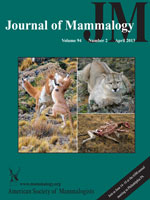Populations of generalist foragers may in fact be composed of individuals that select different prey. We monitored 9 pumas (Puma concolor) in Chilean Patagonia using Argos–global positioning system (Argos-GPS) technology for a mean of 9.33 months ± 5.66 SD. We investigated 694 areas where puma location data were spatially aggregated, called GPS clusters, at which we identified 433 kill sites and 6 acts of scavenging. Pumas as a population specialized upon guanacos (Lama guanicoe), whereas only 7 of 9 individual pumas specialized upon guanacos. One puma specialized upon domestic sheep (Ovis aries) and 1 upon European hares (Lepus europaeus) in terms of numbers of prey killed. Male and female pumas selected different distributions of prey and pumas exhibited prey selection at both the individual and population level. Three of 9 pumas exhibited selection when we compared individual prey use to prey availability within individual pumas' home ranges. One puma selected endangered huemul (Hippocamelus bisulcus) and 2 selected sheep. When we compared individual prey use to prey use at the population level, 5 of 9 pumas differed from the population norm. Whereas pumas did not select huemul at the population level, 2 individuals did select huemul. Two individuals also selected domestic sheep, and the influence of these 2 pumas was substantial enough to result in a population-level effect. Our research highlights the need to determine whether pumas exhibit individual foraging variation throughout their range, the extrinsic factors associated with (and possibly influencing) such variation, and how pumas that select rare and less abundant species in multiprey systems impact recovering prey populations.
How to translate text using browser tools
1 April 2013
The effects of puma prey selection and specialization on less abundant prey in Patagonia
L. Mark Elbroch,
Heiko U. Wittmer
ACCESS THE FULL ARTICLE

Journal of Mammalogy
Vol. 94 • No. 2
April 2013
Vol. 94 • No. 2
April 2013
diet
European hare
global positioning system (GPS) cluster
guanaco
Hippocamelus
Lama
Patagonia




